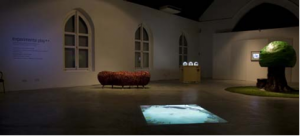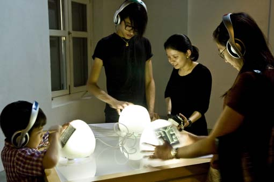July 2008, Singapore

Installation view Experimenta Play ++, Sculpture Square, Singapore July 2008. Photo- Priscilla Bracks
In July 2008 I travelled to Singapore to attend ISEA (International Symposium of Electronic Arts) and to present my work in Experimenta Play ++, an exhibition within the ISEA program featuring 5 works by Australian artists.
The ISEA conference was divided into five main themes: Locating Media, Wiki Wiki, Ludic Interfaces, Reality Jam and Boarder Transmissions. Experimenta Play ++ was curated around the theme of ‘Ludic Interfaces’. The playful means of interacting with these works ranged from an apparently still photograph of people who got scared and ran away if they ‘sensed’ someone looking at them (The Shy Picture), glowing pods that can be moved to navigate through an illustrated world touching the screen to effect the lives of the people who live within (Charmed), and a couch that gurgles and vibrates when touched (ZiZi).
The show was officially opened on 28 July at an event hosted by the Australian High Commission, which attracted many curators and artists. Gavin Sade and I were interviewed that evening for the Australian documentary series Not Quite Art. This interview and our work was shown in an episode of the series which aired on the ABC 24 October 2008. The work was also featured in an article published by Singapore’s daily tabloid Today.

Audience interacting with Charmed (2007) Photo- Priscilla Bracks
The conference provided a great opportunity to promote my work internationally through media interviews and a joint conference presentation with fellow artist Gavin Sade, but beyond these very tangible career development opportunities, I also benefited enormously from the opportunity to interact with artworks, and meet the people who created them. A fantastic group of artists presented their work within the conference program, providing an opportunity to engage with some unique ideas and learn about the creative process that transformed these ideas into new media works.
One of the most inspiring collaborations I encountered were SWAMP (Doug Easterly and Matthew Kenyon). Easterly and Kenyon’s work is concerned with organizations, and elements of our culture that are counter-creative or even dehumanising. Focusing on entities such as Wal-Mart and government bureaucracies, SWAMP works to reveal how despite being created and managed by people, these entities take on ‘meta-human’ characteristics with a life and will of their own that is sometimes in conflict with human needs and interests. Their work uses art and technology to deal with social issues in a remarkable way. One work detailed by Easterly and Kenyon during their conference presentation was Notepad, a set of 50 notebooks that look like ordinary lined writing pads, except that the lines on each pad are drawn by lines of micro text documenting the name, date and place of death of Iraqi civilians killed in the US conflict. Each character is barely a millimetre high, so the text looks like a line until examined under magnification. The work was made in response to a US administration statement that it would not record civilian deaths, so SWAMP printed multiple editions of each set and encouraged people to send letters on this paper to members of congress so that they would be filed in the National Archive. I found this approach to social activism through art really inspiring. I met Doug and Matt at the conference and spent some time discussing ideas. We have stayed in contact and I plan to catch up with Doug when I travel to New Zealand in early January.
ISEA provided a rare opportunity to see a large body of new media art with exhibitions of artists from around the world including New Zealand, Switzerland, Australia and the Juried Show at the Singapore Art Museum which brought international artists to Singapore to make work during a 3 month residency. I reviewed this exhibition in an article written for www.we-make-money-not-art.com.
One group in that show whose work was of great interest to me were Vladan Joler and Kristian Lukuc, (the Eastwood Real Time Strategy Group). Joller and Lukuc created a modification of the computer game Civilisation. In their version, Civilization V, game play centres around the contemporary dream story of building a technology company empire. Players choose their company and instead of warriors and generals, employ CEOs and lawyers to build an army to win the war for market-share dominance. The work critiques the use of affective labour by gaming companies and social networking sites, to produce profit for shareholders without any real benefit to the creator/user. These concepts are brought to the fore in the games various interface options such as Advisors where you can build your company’s proficiency in Folksonomy & the art of classifying people into demographics, Viral Marketing, and Love Bombing (heaping love onto new members of a social group), a technique most often associated with religious cults that is now used increasingly in social networking web forums.
The underlying code and logic of this game is the same as the original commercial version so the principle strategies remain the same: find the resources in the economy that make you successful. However unlike the original game these resources go beyond the obvious to include resources of the new economy such as loneliness, depression and boredom, which are a key to the popularity of social networking sites.
Seeing/using these works and meeting the creators was a great experience because I also work in this area of social commentary through art and playful interfaces. These works offer many levels of engagement for audiences, depending on their level of interest.
The ability to share and exchange ideas about the language and form of interactive media art as a means to express social commentary was of significant benefit for me. Whilst there is a large body of new media work centred on playfulness, this experience illustrated that there are many effective models for exploring these quite serious concerns through play and forms that are employed in popular culture. I’d like to thank ANAT for assisting me with funds to attend this event.
Tags: Boarder Transmissions, ISEA, Ludic Interfaces, ocating Media, Reality Jam, Wiki Wiki




